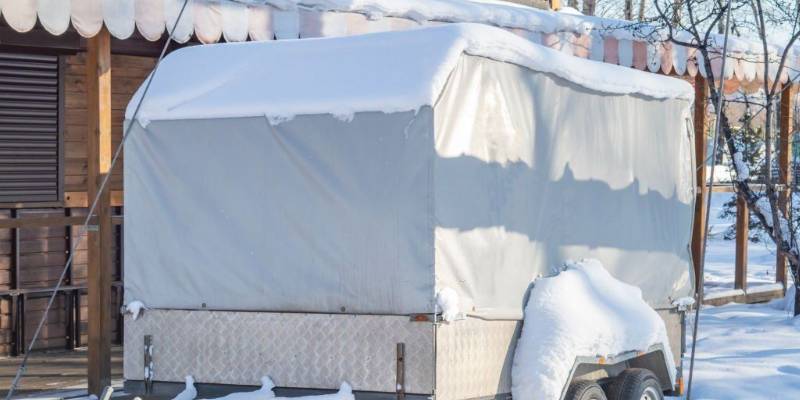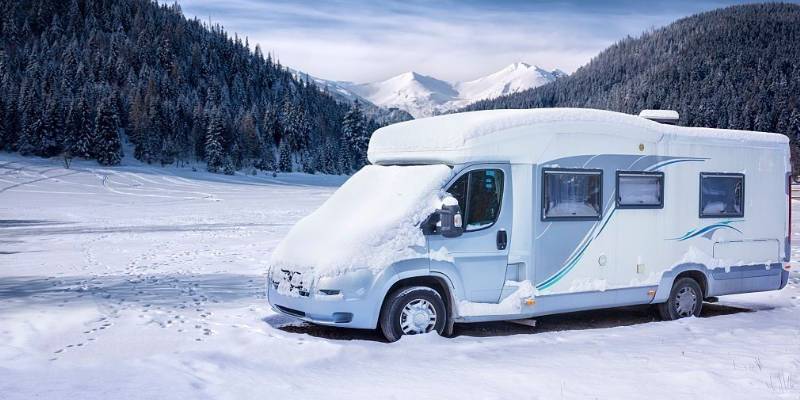
Whether parked in the barn of the nearby farm in your own garage or outdoors, your RV has to spend the winter somewhere. If the RV has to be parked for a few months or even years, you may be asking yourself: Is an RV protective cover useful or even necessary for the winter?
RV protective covers are useful equipment for every motorhome owner. RVs parked outdoors in particular are exposed to UV damage, water, or environmental toxins. With special tarpaulins, the negative effects are reduced enormously, especially for the paint. If you don’t heed this advice, repairing the damage will cost you far more money than investing in a suitable tarpaulin.
In fact, we consider RV covers to be one of the most sensible investments when it comes to maintaining the quality and longevity of the trailer. Without a protective cover, not only the outer skin is damaged, but the resale price of your RV also drops dramatically! Ultimately, Selling a used motorhome hinges on appearance. A trustworthy look is crucial; few buyers want an RV that seems unreliable.
When Does a Camper Cover Make Sense?
In short, every RV and motorhome needs a protective cover. Even for RVs that are parked under a roof, it is worth buying a good protective cover: the vehicle stays clean and is not permanently exposed to external influences. However, It is only worth investing in a good-quality case. Those who save at the wrong end are often better off without a cover. An inferior cover hood could damage the paintwork for example. We show today in the purchase advice below what is important.
What are the Dangers of Improper Parking of the RV?
Wintering your own RV doesn’t sound particularly complicated at first. Empty the tanks and clean them if necessary, clean the interior, remove annoying odors from campers, dispose of leftovers, lock and secure with an alarm system – done.
But it’s not that easy after all!
There are actually a few dangers and pitfalls when it comes to safe trailer winter storage. When you park your RV outdoors, there are a variety of possible scenarios in which your vehicle can be damaged.
Are you a homeowner? Or have you ever found an item you thought was lost outside in the garden after a very long time? Then you know what we’re talking about. Mother Nature isn’t exactly kind to things that have been sitting around for years!
The following dangers threaten a caravan without a special protective cover:
- Ice and snow
- Acid rain
- UV exposure from sunlight
- Hail
- Storms and parts flying around as a result
- Damage from sand and sandstorms
- Bird droppings
- Tree sap
If these dangers exist long enough because the trailer is wintering outside, the effects on the paintwork and structure of the vehicle are serious: Scratches, moss, dust, corrosion, and UV damage are the usual consequences.
The outer protective layer usually consists of a glass fiber coating, which can oxidize over the long term and is therefore vulnerable. This process can be observed. First, the paint or varnish becomes more matt than before. The fiberglass layer weakens and eventually provides little protection from the elements. Once this is done, the rest of the hull is vulnerable as well. Ultimately, this is to be avoided!
Once the damage has reached this stage, it can be difficult or expensive to restore it to its original condition. Specialists usually charge a lot of money for this complex work.

Another unpleasant side effect: the resale value of your RV drops significantly. It becomes a lot harder to sell a vehicle that is showing signs of wear and tear. In any case, you get a lot more for a used RV that looks perfect and has little damage. In addition, every potential buyer will also consider the entire look. Once your trailer has lost its original shine and polish, it doesn’t do well for an acceptable retail price.
The well-preserved paintwork in bright white is a sales argument, especially for light-colored RVs. Without a cover, it becomes far more likely to spend significantly more time cleaning the camper just to maintain the status quo. So you see – a good RV cover prevents many problems before they can occur. Tarpaulins for caravans are therefore a sensible investment no matter what you plan to do with your caravan!
Stay Away from Cheap All-Purpose Tarpaulins
Before we get to the things you need to consider when it comes to choosing the right tarp, do yourself a huge favor and steer clear of cheap hardware store tarps. These all-purpose tarpaulins are of course tempting as they are incredibly cheap to buy compared to specialist RV covers. Not only do they offer your RV less protection, but they are also even harmful.
Such fabric tarpaulins (made of polyethylene) are completely waterproof and therefore no longer breathable. Especially in winter, we have the problem that the humidity is very high. This allows a fair amount of moisture to collect under the tarpaulin itself. This moisture slowly builds up more and more and cannot drain away properly. In addition, ice forms in cold weather due to the backwater.
This has several serious consequences for the trailer:
- Firstly, the air inside the vehicle can no longer circulate properly. A nightmare – not even a good dehumidifier for the caravan will help here!
- In addition, the formation of rust is promoted and the longevity is drastically reduced.
- Another bad consequence is the formation of mold, not only on the inside of the tarpaulin. The mold can spread to the interior of the caravan and thus cause extreme costs.
You see – the cheap hardware store tarpaulin is not a solution, but a cost trap!
How long do camper covers last?
When choosing the right cover, the longevity of the cover stands and falls with the quality of the material. Quality covers often last for many years, while cheap tarpaulins can suffer premature damage.
It is not for nothing that well-known brands advertise longer durability: An investment in more expensive brands such as Classic Accessories and Leader Accessories lasts longer than the cheap hardware store product. These well-known companies would quickly have an image problem if the expensive protective cover was ready for the dustbin after a winter.
Consider This When Choosing the Right RV Cover
We have now sufficiently clarified that a protective cover for RVs is useful. Nevertheless, it remains to be clarified what is important when selecting the right protective tarpaulin and how to proceed. When making your selection, you should pay attention to various criteria:
- The correct size of the tarpaulin depends on the vehicle
- Textile fabric should be breathable, waterproof, light, and UV resistant
- Depending on the location and purpose, consider zippers and special features (e.g. thermal insulation).
- Secure fastening with tension belts
- Theft protection
First of all, you should definitely make sure that your RV is the right size because tarpaulins come in all sorts of sizes and shapes. Take a close look at the motorhome vehicle documents and make a note of the length, height and width of the trailer. If your caravan has structures on the roof (air conditioning, satellite dish), add these parts with their dimensions. You have already determined the necessary size for the RV cover.
But what if you own an exceptionally large or small caravan or are simply looking for an individual custom-made product? There are manufacturers who offer unusual sizes and custom-made products for precisely these requirements.
After you have determined the right size, it is now a question of the material and design of the protective cover. The material of the fabric consists of fleece, in the English-speaking world one often finds the reference “nonwoven”.
Many RV covers offer more than just obligatory waterproofing. There are covers that offer special thermal insulation or are even offered with zippers. When selecting such additional functions, it is very important how and where the caravan is parked.
Things to consider include the climate in which the RV will be parked or how often you expect to enter the RV during that time. If you often want to look inside your RV, you should pay attention to zippers.
If you live in a particularly cold region of the Swiss Alps, heat-insulating covers are the right choice. In this way, your RV is better protected from the effects of cold winter weather.
As always in life, there is a multitude of options for RV protective covers, which often overshoot the mark in terms of price. You should be careful not to buy the cheapest of the cheap because with these tarpaulins you have to ask yourself whether you can expect adequate protection.
On the other hand, you don’t necessarily need a tarpaulin with particularly fine materials and special functions, even if a good price-performance alternative from a trustworthy company will do. So look out for trustworthy, renowned companies such as Hindermann or Brunner.
Where Can I Buy RV Covers?
RV tarpaulins are available in specialist shops or in various online shops for camping supplies. Camping Wagner offers a good selection of different protective covers for caravans. At Amazon, you get a huge selection with a comfortable filter system for the right size of tarpaulin.
How expensive are RV tarpaulins?
The cost of purchasing a protective cover for RVs varies greatly and is primarily determined by manufacturer awareness, size, and quality of workmanship. The price is almost always between 50 and 800 dollars. The usual purchase price is 150 to 300 dollars for a usual length of 6.50 meters with an average quality of tarpaulin. Special extras such as zippers and tension belts drive up the acquisition costs.
Conclusion – Safety First
RVs are quite large and tall which means you will also need large covers to cover them. If you want to fit a camper or RV cover, we always recommend doing it in pairs and in small steps, so you can do the job more easily and avoid dangerous situations. Of course, the same applies if you want to remove the cover again. Some covers also come with handy storage bags that allow you to compactly store the cover.
If you have any questions, leave a comment below and we’ll answer them.